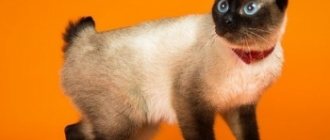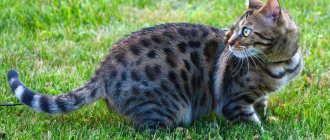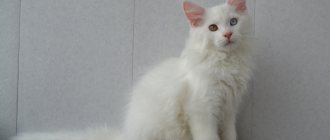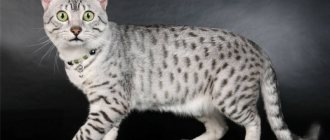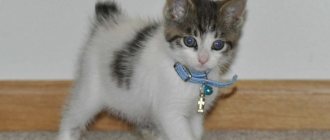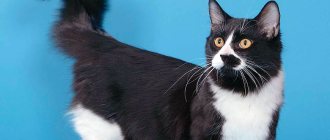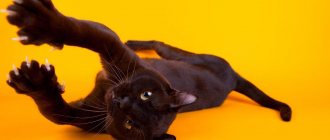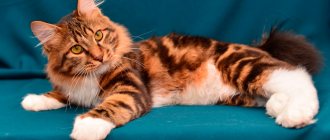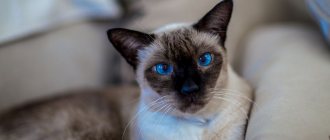Among pet lovers there are quite a lot of fans of Scottish Straight cats. The nature of the pets allows them to be kept in families with small children. However, the breed requires care and knowledge of the animal’s character. In order for your pet to feel good, you should take proper care of it. Scottish cats are a breed that appeared relatively recently, but in a short time the animals were able to win the hearts of both ordinary breeders and charm people specializing in breeding. At first glance, the appearance of the pets is ordinary, but there are quite unusual and exceptional features that attract many. Representatives of the Scots sometimes look formidable, sometimes strict, but at the same time they are always so sweet.
Some confusion
The Scottish Straight cat, the photo of which is presented in this article, is a close relative of the Scottish Straight. However, the characters of the animals are radically different. Often the habits of the latter cause bewilderment among breeders; they cannot be kept in a family with children due to excessive aggressiveness and intolerance even with small pranks.
The characteristics of Scottish straight-eared cats are radically different. They are completely different from their relatives. However, before purchasing them, it is necessary to find out the characteristics of the animal’s character and its standard habits, so that if difficulties arise in upbringing, you will be able to cope with them.
Table: pros and cons of the breed
| pros | Minuses |
| Beautiful appearance | Expressed independence and rejection of excessive affection from owners |
| Calm and flexible character | Tendency to joint pathologies (for the Scottish Fold variety) |
| Lack of aggression | If something doesn’t suit you, it can show character |
| Excellent adaptation in families, including those with small children | |
| Good breeding and excellent learning ability |
Description of the Scottish Straight cat
Scottish cats differ in a number of characteristic features that are unique to this breed. Sometimes animals are often confused with the British species, but during the comparison process the following differences can be identified:
- more rounded head;
- the body has an oblong and elongated shape, which gives the animal elegance;
- body proportions are slightly reduced;
- the average weight of a cat is 3 - 5 kg, boys weigh slightly more than females;
- pets are very flexible and remain hardy and playful at any age.
Disadvantages of the breed
- Health. As a rule, Scottish Folds do not have major health problems, but there may be some features that require the owner's attention. Occasionally, they have genetic diseases. The gene responsible for the unusual shape of the ears also carries hereditary abnormalities of the musculoskeletal system. Of course, careful selection greatly reduces the incidence of these abnormalities, but since this genetic disorder is associated with specific ear shapes, the gene cannot be completely eliminated. Such animals may experience osteochondrodystrophy (congenital bone deformation) and hemophilia (blood clotting disorder). In addition, diseases of the internal organs are possible, so it is recommended to regularly visit a veterinarian for a timely examination.
- Features of the ears. Scots' bent ears produce too much wax, so cleaning the ears with a damp cotton swab is necessary once every 10 days.
- High cost compared to other cat breeds.
Straight-eared Scottish cat: character and habits
Inexperienced breeders often wonder how to determine in advance the future character of a kitten. It is well known that Scottish Straight babies show a special disposition already in the first months of life. As soon as the babies' eyes appear and they begin to crawl around the apartment, it becomes clear whether the cat will be balanced and obedient. Perhaps he will become a tireless and energetic researcher. Or perhaps the kitten will become a phlegmatic, calm cat.
Kittens of this breed, even born from the same mother cat, may be completely different in habits and character from each other. Sometimes it seems that it is impossible to determine which of the mischievous kids will be the optimal pet for a particular family.
Mating of representatives of the Scottish breed
The main thing you should know before breeding “Scottish cats” is that both the female cat and the female cat must not belong to the Scottish Fold variety. The offspring from such a cross will appear with serious pathologies. It is also not recommended to mate with other breeds - the consequences can be very unpredictable.
The cat is ready for pregnancy and childbirth at the age of one and a half years. It is ideal to breed after the female has gone through two heats. The cat should go on a “date” on the third day of estrus. To ensure a guaranteed result, you will need to leave it with the cat for two to three days.
Before mating, both partners must be vaccinated against all possible infections. Two weeks before vaccination it is necessary to carry out deworming. It is advisable that the cat be experienced, especially if this is the female’s first mating. It is also important that the “groom” be larger than the female - he must be able to simultaneously grab her withers with his teeth and reach her rear. If the cat cannot do this, the owner will have to hold the cat by the withers.
Naughty family friend
Young Scots with a strong temperament are constantly trying to run away somewhere, hardly sit still and are actively exploring the world around them.
Inquisitive furry creatures sniff very carefully at unfamiliar smells, listen to any rustles, frolic with their brothers and sisters for a long time and always try to stir them up.
Playful animals show their hunting instincts at any convenient moment. Such kittens are either trying to catch their tail or hunting for shadows. But in any case, they are the only ones who initiate playful pursuits.
Ear diseases
Congenital ear problems are rare. Usually they are expressed in an underdeveloped internal part or its irregular shape. In this case, the shell is simply not adapted to perceive sounds, and it cannot be corrected. In addition, lop ears contribute to the accumulation of dirt in the sink. Against this background, an infection may develop. Otitis media and tumors reduce the cat's hearing. In the advanced version, complete deafness occurs. Treatment is carried out using injections, local drops, and ointments.
How to care for a sick cat?
Balanced and calm family member
If you need to get a non-capricious and balanced kitten who will not constantly jump and regularly demand attention, you need to take a closer look at the babies who sit apart in the basket. Usually such kids do not participate in the fun of others, and if they are drawn into the game, then the kittens join in without much enthusiasm.
Balanced kids love to sleep and spend a lot of time alone. If they begin to explore the surrounding space, they do it alone.
There is even a pattern by which you can identify a calm, straight-eared Scottish cat. The character and habits of such a baby will be distinguished by calmness and balance in its external and internal manifestations. The kitten carefully touches various objects with its paw, does not strive to constantly be the center of attention and does not involve other pets in its explorations.
Such an animal gets very used to its owners and becomes a family favorite. Usually these cats are immersed in themselves and try to somewhat isolate themselves from others.
Requirements for appearance and exterior
In relation to Scottish Folds, certain standards apply, according to which the breed of the animal is assessed at exhibitions and in expert commissions. Certain points are awarded for body structure and coat condition:
Head 55 points:
| 1 | Ears | 25 |
| 2 | The shape of the head, muzzle, chin, neck. Profile | 15 |
| 3 | Eyes | 15 |
Body – 40 points:
| 1 | Structure/shape, limbs | 10 |
| 2 | Tail | 20 |
| 3 | Wool | 10 |
Coat color and eye color – 5 points
Factors influencing the habits of the Scots
Scottish straight-eared cats are gaining popularity among ordinary people and professional breeders due to their character and unusual appearance. Animals can react quite adequately to children's pranks, so their nature allows them to be kept in families with children.
The character, habits and habits of the breed can be influenced by various factors and life circumstances. Therefore, the characteristics of Scottish straight-eared cats can be directly related to the very upbringing of the kitten and the conditions of its keeping. The breeder needs to pay attention to:
- pet's habitat;
- his surroundings.
Habits can change greatly due to the presence of other animals in the house, as well as due to various medical procedures required for Scottish Straight cats. The character of a sterilized or neutered animal differs from that of the one that bears offspring. Let's consider the factors that most influence the breed's leashes next.
Health, feeding and care
The rules for caring for a Scottish Fold cat are not much different from the standards of care for other breeds, but it is important to take into account some nuances:
- The “tartan” coat cannot be combed with a slicker brush, only with a regular metal comb, so as not to tear out the undercoat. It is noteworthy that this breed loves to be brushed against the grain!
- In addition, ears should be cleaned more often than other breeds require, since due to their unique characteristics, more wax accumulates in “loop ears.”
- It is also important to wipe your eyes at least twice a week - mucus constantly accumulates in their corners.
The Scottish Fold cat's diet should include premium ready-made food and natural food. Make sure that your pet’s menu always includes lean meat (preferably beef and chicken), twice a week - boiled sea fish (but not river fish, it is harmful for this breed), chicken yolk, liver, cottage cheese, cheese, vegetables and cereals .
It is also recommended that “Scots” be given sprouted wheat and special grass (they can be bought at a pet store, just like ready-made food for Scottish fold cats).
But what you should give up is: potatoes, lamb, sausage, onions and pork.
Surrounding area
Reviews about the habits of the Scottish straight-eared cat and the nature of his behavior confirm the fact that these are quite calm and balanced animals. Professional breeders say that pets can change significantly due to the human factor. For example, the presence of mischievous children in the house can have both a negative and a completely positive effect on a kitten.
If adults allow children to treat kittens roughly and cruelly, not realizing that pets are vulnerable and weak, then as they grow up, the animals may become withdrawn, angry and suspicious. Cases have been recorded when pets began to take revenge on their owners. If children and adults approach the cat with affection and are kind to it, then the animal grows up calm and, depending on its disposition, mischievous or peaceful.
How to choose a Scottish Straight kitten
It is best to purchase purebred kittens from specialized nurseries. You can search for nurseries that suit you on the Internet.
When you have decided on the choice of nursery, you should choose a baby. When choosing a kitten, pay attention to the fur (it should be soft, without bald patches or mats), the ears (they should be clean), the belly (it should be slightly swollen) and the gait. Also find out from the breeder the age of the kitten. He must be at least 2.5 months old, since only after this age can he be separated from his mother. When purchasing a pet, you must draw up a sales contract. The breeder will also give you the animal’s veterinary passport and its pedigree.
A purebred cat must have a veterinary passport and pedigree
Scottish Straight kittens with all documents can be purchased from 7,000 rubles and above.
Location
Place of residence and living conditions have a great influence on the formation of the character of the Scottish Straight cat. The character of the animal greatly depends on these circumstances. It is known that without proper care, animals have difficulty adapting to their environment and become angry, aggressive and withdrawn. However, the breed is very self-sufficient. A cat needs its own private corner where it can feel comfortable and relax.
Scots are very attached to home and family members. Relocation has a serious impact on them. Such changes in life can turn a self-confident animal, affectionate and playful, into a cowardly and embittered one.
Reviews about the character of the Scottish Straight cat indicate that he can live quite comfortably in the courtyard of a private house. Animals are excellent catchers and getters. They often defend their possessions from rodents, birds and other creatures and also obtain their own food.
If a Scotsman lives in an apartment, then the kitten grows up less active and independent. However, reviews indicate that in this case the animal is more attached to the person and shows its affection more actively.
Such pets love to sleep on the laps of household members and play gambling with children, if they are not cruel. Also, the Scots are quite peaceful with other pets. But, according to reviews from most breeders, Scottish Straight cats are very picky when it comes to nutrition.
Myths
First, I would like to dispel some fictions presented as reality regarding the Scots or Scottish, as they are also commonly called:
- Lack of aggression. Although breeders have made a lot of efforts to eliminate the breed with this trait, from time to time a restless kitten appears in the litter. It is also worth remembering about upbringing and the environment. If you harass and harass an animal, sooner or later it will show itself from the negative side.
- The temperament is even and therefore puberty occurs later than is customary in cats. Error! All Scottish cats mature at 5-8 months, and a pet that has gone on a spree purrs no quieter than the rest.
- For the Scots, the home environment is more pleasant than the street environment, so they are homebodies. Partly true belief, Scott pets prefer indoors to walks. But it is quite possible to leave the house with them - the animals will show curiosity, interest and attention. Changes at home also do not create problems for them.
- Attachment to only one person is a myth! Although this is determined by the specific character of the animal (yes, their affection for a specific family member may be obvious), most animals love everyone in the household approximately equally. If people quarrel, the cat will try to restore peace and tranquility in the family. He is happy only among people he knows; nothing pleases him more than friendly family evenings.
- The breed is considered to be the calmest and laziest. And here again is a myth! Among the Scots there are corresponding lazy couch potatoes, and those who like to talk, run, overcome obstacles, talk (especially young individuals who are still outgrowing these inclinations, but not 100%).
- The breed has well-developed instincts, so it is easy to train. There is a chance that by using instincts, you can teach your pet some tricks. The Scots do not have a particularly high learning ability.
- Bad hunters are a myth. If a kitten is trained by its mother to catch rodents, it will be able to realize this opportunity. Pets that are fully domesticated will perceive the mouse as a toy.
Presence of other animals in the family
Scottish Straights often look down on other pets. However, if they were brought up with such people from childhood, then such an attitude does not arise. When a kitten ends up in a home inhabited by other animals, the owners can rest assured of a positive outcome. The baby will definitely get along not only with his relatives, but also with birds, tame rodents and even dogs.
The character of the Scottish straight-eared cat, who grew up in the same house with dogs, is distinguished by mischief and cheerfulness. These animals are cheerful, agile and very attached to their owner.
But living in the same house with felines, the Scots can become overly jealous. In this case, they become attached to cats more than to members of the household and the owner.
Story
As a result of the research, it turned out that the first fold cat was brought from China to Europe by an English sailor - this happened at the end of the 18th century in 1796.
But there is another version, which says that a certain Scottish farmer saw his neighbor’s female kitten with drooping ears, born from an ordinary yard cat. The baby's name was Susie, and over time she gave birth to children with the same funny ears. One kitten named Snowball was given for mating with a British cat - as a result of which several babies were born with drooping ears.
Breeders began to work closely on breeding the fold-eared breed and received amazing results. It turned out that babies with curled ears are born only by mating fold-eared and straight-eared cats. If you “breed” only fold-eared cats, then some kind of mutation occurs and the kittens are born deaf and blind. Therefore, geneticists carefully select pairs for mating and have developed a special program with an “algorithm formula” that promotes the correct breeding of the Scottish Fold breed.
Officially, the Scottish Fold cat breed was registered only in the late 60s of the 20th century.
Leisure influencing character
The character of Scottish straight-eared male cats is somewhat different from girls. Males more often show their hunting skills, strive to get their own food and show strength in the process of protecting themselves. Females are more affectionate and playful, but if they have offspring, they can show aggression.
In order for a kitten to develop harmoniously, it needs a variety of toys. If there are a lot of them, then the pet is unlikely to turn into a glutton, a calm phlegmatic person or a lump. Such a Scot will be characterized by agility, energy and a desire to hunt.
Problems with the gastrointestinal tract
Fold cats are most often diagnosed with:
- inflammation of the stomach;
- liver dysfunction;
- food allergies;
- helminthiasis
Signs of diseases of the digestive tract:
- refusal of the animal to eat;
- lethargy;
- strong thirst;
- vomit;
- defecation disorder;
- the presence of undigested food pieces in the stool.
YOU SHOULD KNOW! Disorders of the digestive system in cats can also be indicated by eczema of the skin.
Only a veterinarian is involved in diagnosis and treatment.
The Scot as a true friend
Many people want to get a representative of this breed because the animals are obedient. For your pet to understand that they are angry with him, it is enough to change his intonation. Reviews from breeders show that it is quite easy to train small kittens to use a tray. If necessary, they can relieve their needs in the courtyard of a private house. Scottish Straight cats quickly learn what is permissible to do in the house and what will be punished. Many Scottish owners say that it is not scary to leave such a pet at home alone, because it does not harm property. Often breeders find an animal in the same place where it lay before they left.
However, this does not mean that the animal is inactive. Scottish Straight cats are very inquisitive and playful. Animals often do not know how to stop when participating in games, so it is worth limiting pets in their natural instincts and not allowing them to scratch themselves or household things.
Knitting features
Scottish Straight cats are ready for the first mating at 9–10 months, but this should not be allowed at this age, since during pregnancy during this period the female may develop serious illnesses, and all offspring may die. At one and a half years old, a cat can already be bred. You should choose a partner in advance, because estrus lasts 5–6 days.
Scottish Straight males can be bred when they are 10 months old. From this age they can be knitted at any time. Increased activity occurs in the spring. The cat becomes restless, aggressive, and begins to mark its territory.
Choosing a partner
You can only breed a Scottish Straight with cats of the Scottish breed (Straights and Folds), since they are direct relatives; mating with British cats is prohibited. When choosing a male, choose an older male cat. Also make sure that the cat is healthy and vaccinated. When mating, the female is left on the male’s territory, so prepare for her what she usually eats, and also bring a tray with you. Also, the cat should cut its nails, as it will try to scratch the cat with them.
Progress of pregnancy
If the mating was successful, then after a while the cat may begin to feel sick in the morning, her appetite may increase or her food preferences may change, she may become more lethargic, apathetic, and sleep most of the time. All these signs indicate that the cat is pregnant.
Pregnancy in Scottish Straights lasts 60–65 days, but sometimes it can last as long as 72 days. It all depends on the weight and age of the cat, as well as the number of kittens she is carrying. If the cat is young and weighs up to 3 kg, then pregnancy can last even 50 days, but this will have a bad effect on the offspring.
During pregnancy it is prohibited:
- give your cat pills and medicines for fleas and worms;
- feel the cat’s belly with your hands, as you can harm the kittens;
- dramatically change the cat’s diet, for example, switch from natural products to dry food and vice versa;
- pick up the cat;
- let out into the street.
Castration and sterilization
If you do not want to breed Scottish Straights in the future, then most likely you will decide to spay or neuter your pet. After these operations, the animal will not be able to have offspring. There is a popular belief that castration is a procedure for removing the testes of a cat, and sterilization is carried out in cats. But that's not true. Both castration and sterilization can be carried out on both females and males.
Sterilization is a procedure after which the animal will not be able to have offspring, but the desire to mate will remain. During sterilization, a cat's fallopian tubes are ligated, and a cat's spermatic ducts are ligated. This operation can be performed between 10 and 12 months, since the animal has already reached puberty.
Castration is an operation in which the organs responsible for the reproduction of animals are completely removed. Castration, like sterilization, can be carried out from the moment the animal reaches sexual maturity. There are two types of these operations for cats:
- ovariohysterectomy, in which the ovaries are removed along with the uterus;
- oophorectomy, in which only the ovaries are removed.
Both of these operations are completely safe and do not take much time.
Video: is it worth spaying or neutering your pet?
Tartan standards
global $ads_google;
//data-ad-slot=”2475549904″ $ads_google = empty($ads_google) ? false : true; ?> if ($ads_google == false) {?> $ads_google = true; ?> } ?> The Scottish breed today is divided into two genetic lines due to breeding work. One line is associated with the British, Persians and even exotics, the other with American Shorthair cats.
The standards of each subspecies will be discussed below, but all Scottish cats have common appearance features that indicate their belonging to the breed.
The head must be round in shape with large round eyes. The breed is characterized by a “childish” expression on its face. The fold-eared varieties are similar in ear shape, and the short-haired subspecies have a very thick undercoat, and resemble teddy bears.
Other breeds may simply be envious of the richness of the colors of the tartans. As a rule, the eye color corresponds to the standard coat color.
Scottish Fold breed
The Scottish Fold breed does not exceed average size. The body looks rounded, massive and muscular. The back is straight, the shoulders are strong, the chest is well developed.
The characteristic ball-shaped head has a smooth transition to the neck and a strong, well-defined chin. A short nose seems wide. The small ears, which are slightly set forward and downwards, look interesting. The tips of the ears are rounded.
The Scottish Fold looks at the world with wide, large eyes, reminiscent of an owl, and the color of the eyes will be determined by the color of the coat.
Slender round paws of medium length.
Short fur seems plush due to its density and softness. The pile does not adhere to the body.
A cat's tail can be medium or long, but always tapers to a rounded tip.
Straight-eared Scottish breed
global $ads_google;
//data-ad-slot=”2475549904″ $ads_google = empty($ads_google) ? false : true; ?> if ($ads_google == false) {?> $ads_google = true; ?> } ?> The Scottish Straight is a beautiful cat that is small in size and has a sloping body shape. The pussy even seems miniature and compact.
Although the animal is small, its muscles are well developed, including the massive pelvic and shoulder parts. The graceful, rounded paws look strong and feel plush to the touch. The limbs of the subspecies are of medium length.
The head, like that of other Scottish cats, is located on a short but very strong neck. Scottish Straight males have distinct cheeks and whisker pads.
Representatives of this subspecies have a very neat, wide and short nose. The base of the nose and its oval shape are noteworthy.
Smooth, straight ears with soft and elastic cartilage stand out on the rounded skull.
Scottish Straights are similar in eye shape and look to an owl: they have the same large round eyes. Eye color also depends on coat color.
The soft fur coat without thick undercoat resembles plush. Wool is very dependent on the quality of nutrition and climate.
The length of the tail depends directly on the body parameters of the animal, but has a characteristic narrowing towards a rounded tip.
Scottish Fold longhaired breed
As already mentioned, the Highland Fold is a Scots cat with long hair.
Her head is perfectly round, she has a strongly pronounced chin, a strong strong neck, a medium body and short limbs with sloping paws. Round eyes set wide apart.
Males have noticeable cheeks and a short and wide nose. Cats' ears seem to be folded down and forward, and seem to be buried in long hair.
The tail of cats is medium and tapering to the tip.
The wool is light, soft and silky.
What is the difference between the British cat breed and the Scottish cat breed?
global $ads_google;
//data-ad-slot=”2475549904″ $ads_google = empty($ads_google) ? false : true; ?> if ($ads_google == false) {?> $ads_google = true; ?> } ?> There was a whole unpleasant story with Scottish Folds in 1971, associated with the reluctance of the largest felinological organization in Great Britain to include the breed in the official lists. Thanks to the geneticist R. Peltz, the problem was solved. Europe received Scottish Folds from British cats, America - from American Shorthairs. However, in 1976, the CFA finally settled the disputes.
Not everything was smooth with the straight cats either: the cats are very similar in appearance to the British, to whose genes they owe their origin. In 2004, it turned out that the pussies of Scotland differ in character, skeletal mass and skull structure. But today it is prohibited to cross British and Scottish cats.
Scottish cat colors
Scottish cats have a wide choice of colors.
Beautiful colors of chocolate tones:
- plain;
- tortoiseshell;
- tabby;
- smoky;
- bicolor;
- van;
- shaded;
- chinchilla;
- ticked;
- point
The breed is characterized by tipping - the pigment is not distributed evenly along the length of the hair, but only colors the tip of the hair, leaving the rest white. Tipping is found in chinchilla colors, shaded and patterned.
Bicolor colors are popular, consisting of two tones: half white, half blue, cream, red and tabby.
Point colors are popular: the body is light in color, and the muzzle and all protruding parts of the body will be darker. For Scottish cats this is:
- seal point;
- lilac point ;
- blue point;
- chokelit point;
- cream point;
- cake point.
No less beautiful are smoky cats with a uniform coat tone and a white-silver base of the pile.
Solid color Scottish cat:
- blue;
- ebony;
- white;
- lilac;
- faun;
- cream;
- cinnamon.
The rarest colors of tartans today are black, white, chocolate and red.

